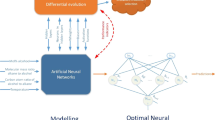Abstract
In this study, the capacity of artificial neural networks (ANNs) and genetic programming (GP) in making possible, fast and reliable predictions of equilibrium compositions of alkane binary mixtures is investigated. A data set comprising 847 data points was gathered and used in both training the proposed ANN and generating the closed-form expressions of the GP procedure. The results obtained demonstrate the relative precision of the proposed ANN, while, on the other hand, exhibit that the GP model, although less precise, affords high CPU time efficiency and simplicity. Concisely, the proposed models can serve the purpose of being close first estimates for more thermodynamically rigorous vapor–liquid equilibrium calculation procedures and do obviate the necessity for the availability of a large set of experimental binary interaction coefficients. Mean absolute errors of 0.0100 and 0.0404 for liquid compositions and of 0.0054 and 0.0254 for vapor-phase mole fractions, for the proposed ANN and GP models, respectively, are a testament to the reliability of the proposed models.


Similar content being viewed by others
References
Hornik K (1991) Approximation capabilities of multilayer feedforward networks. Neural Netw 4:251–257. doi:10.1016/0893-6080(91)90009-T
Widrow B, Rumelhart DE, Lehr MA (1994) Neural networks: applications in industry, business and science. Commun ACM 37:93–105. doi:10.1145/175247.175257
Azari A, Atashrouz S, Mirshekar H (2013) Prediction the Vapor–Liquid Equilibria of CO2-Containing Binary Refrigerant Mixtures Using Artificial Neural Networks. ISRN Chem Eng 2013:1–11. doi:10.1155/2013/930484
Nguyen VD, Tan RR, Brondial Y, Fuchino T (2007) Prediction of vapor–liquid equilibrium data for ternary systems using artificial neural networks. Fluid Phase Equilib 254:188–197. doi:10.1016/j.fluid.2007.03.014
Bilgin M (2004) Isobaric vapour-liquid equilibrium calculations of binary systems using neural network. J Serbian Chem Soc 69:669–674. doi:10.2298/JSC0409669B
Sharma R, Singhal D, Ghosh R, Dwivedi A (1999) Potential applications of artificial neural networks to thermodynamics: vapor–liquid equilibrium predictions. Comput Chem Eng 23:385–390. doi:10.1016/S0098-1354(98)00281-6
Nikkholgh MR, Moghadassi AR, Parvizian F, Hosseini SM (2010) Estimation of vapour-liquid equilibrium data for binary refrigerant systems containing 1,1,1,2,3,3,3-heptafluoropropane (R227ea) by using artificial neural networks. Can J Chem Eng. doi:10.1002/cjce.20272
Mohanty S (2005) Estimation of vapour liquid equilibria of binary systems, carbon dioxide–ethyl caproate, ethyl caprylate and ethyl caprate using artificial neural networks. Fluid Phase Equilib 235:92–98. doi:10.1016/j.fluid.2005.07.003
Faúndez CA, Quiero FA, Valderrama JO (2010) Phase equilibrium modeling in ethanol + congener mixtures using an artificial neural network. Fluid Phase Equilib 292:29–35. doi:10.1016/j.fluid.2010.01.001
Petersen R, Fredenslund A, Rasmussen P (1994) Artificial neural networks as a predictive tool for vapor–liquid equilibrium. Comput Chem Eng 18:S63–S67. doi:10.1016/0098-1354(94)80011-1
Sathya R, Abraham A (2013) Comparison of Supervised and unsupervised learning algorithms for pattern classification. Int J Adv Res Artif Intell. doi:10.14569/IJARAI.2013.020206
Bishop CM, Roach CM (1992) Fast curve fitting using neural networks. Rev Sci Instrum 63:4450. doi:10.1063/1.1143696
Cramer NL (1985) A representation for the adaptive generation of simple sequential programs. In: Proceedings 1st international conference on genetic algorithms. Laurence Erlbaum Associates Inc., pp 183–187
Koza JR (1992) Genetic programming: on the programming of computers by means of natural selection. MIT Press, Cambridge
Schmidt M, Lipson H (2009) Distilling free-form natural laws from experimental data. Science 324:81–85. doi:10.1126/science.1165893
Gandomi AH, Alavi AH, Ryan C (2015) Handbook of genetic programming applications. Springer, Berlin. doi:10.1007/978-3-319-20883-1
Langdon WB, Gustafson SM (2010) Genetic Programming and evolvable machines: ten years of reviews. Genet Program Evolv Mach 11:321–338. doi:10.1007/s10710-010-9111-4
Korea Thermophysical Properties Data Bank (KDB) (2015). http://www.cheric.org/research/kdb/
NIST standard reference database 103b (NIST TDE) (2015). http://trc.nist.gov/tde.html
Cybenko G (1989) Approximation by superpositions of a sigmoidal function. Math Control Signal Syst 2:303–314. doi:10.1007/BF02551274
Marquardt DW (1963) An Algorithm for least-squares estimation of nonlinear parameters. J Soc Ind Appl Math 11:431–441. doi:10.1137/0111030
Levenberg K (1944) A method for the solution of certain non-linear problems in least squares. Q J Appl Math 2:164–168
Hagan MT, Menhaj MB (1994) Training feedforward networks with the Marquardt algorithm. IEEE Trans Neural Netw 5:989–993. doi:10.1109/72.329697
Schmidt M, Lipson H (2015) Eureqa, Nutonian Inc., http://www.nutonian.com
Peng DY, Robinson DB (1976) A new two-constant equation of State. Ind Eng Chem Fundam 15:59–64. doi:10.1021/i160057a011
Author information
Authors and Affiliations
Corresponding author
Ethics declarations
Conflict of interest
The authors declare that they have no conflict of interest.
Electronic supplementary material
Below is the link to the electronic supplementary material.
Rights and permissions
About this article
Cite this article
Roosta, A., Hekayati, J. & Javanmardi, J. Application of artificial neural networks and genetic programming in vapor–liquid equilibrium of C1 to C7 alkane binary mixtures. Neural Comput & Applic 31, 1165–1172 (2019). https://doi.org/10.1007/s00521-017-3150-1
Received:
Accepted:
Published:
Issue Date:
DOI: https://doi.org/10.1007/s00521-017-3150-1




